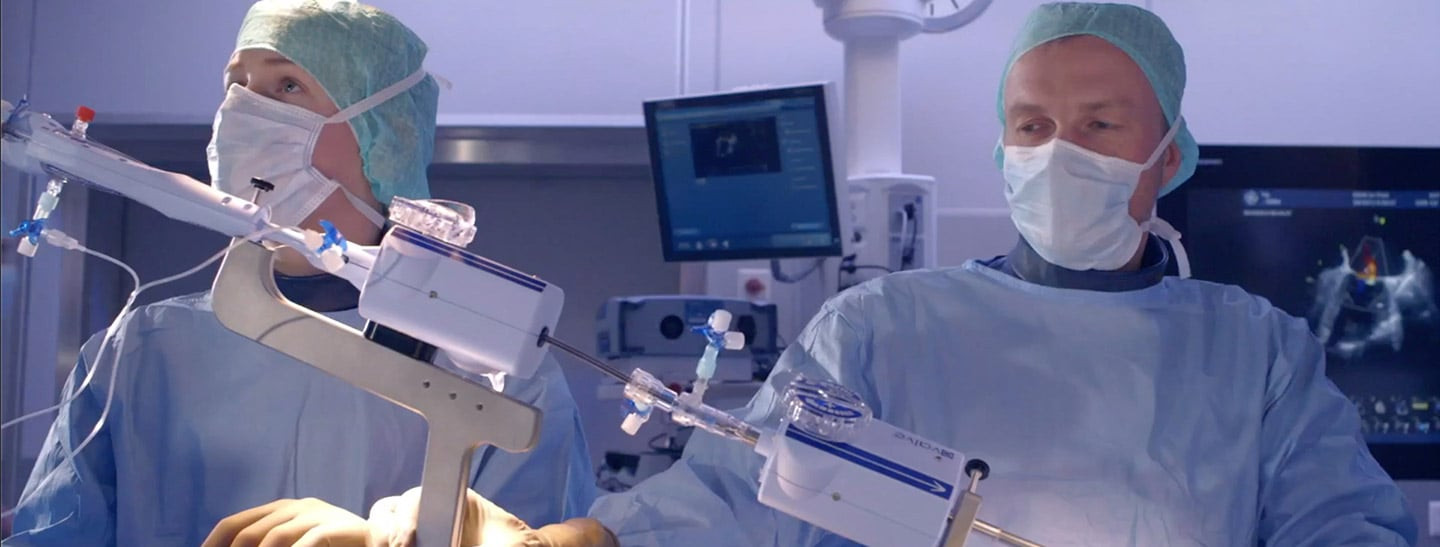Klicken Sie auf Einstellungen, falls Sie diese ablehnen möchten.

Cardiac catheter or cardiac surgery? In the therapy of heart valve defects, catheter-based methods are playing an increasingly important role and the choice of the best method is decisive for the respective patient. It is not only dependent on the risk and and desired outcome of the procedure, but also, and increasingly, on patient preference.
What are heart valve defects or diseases of the heart valves?
A heart valve defect refers to a congenital defect or acquired malfunction of one or more heart valves. The heart has four valves that act as valves in the organ. If they function correctly, they control the flow of blood and prevent it from flowing back in the wrong direction. In the left heart, there are the mitral valve and the aortic valve. In the right heart, they are the tricuspid valve and the pulmonary valve. Common heart valve defects are narrowing due to calcification of the aortic valve, aortic valve stenosis, and leakage of the mitral valve, mitral valve regurgitation.
Such diseases of the heart valves, aortic and mitral valves, occur frequently, but often go unnoticed for a long time. Depending on age and concomitant disease, the incidence can be more than 20%. Some, however, can worsen and become threatening. They lead to heart failure and shorten life expectancy. Typical symptoms of heart valve defects can include fatigue and shortness of breath, but also dizziness and brief loss of consciousness.
Most heart valve defects are mild and only require regular check-ups. Drug therapy can alleviate symptoms. In most cases, however, timely repair or replacement of the heart valve is necessary to avert permanent damage to the heart and maintain a normal life expectancy.
Open surgery or catheter-based method?
Choosing the right time and the best method for therapy is obviously central for the individual patient. Both heart diseases can be treated with open-heart surgery or, for the past 15 years, with a minimally invasive procedure via groin artery using a catheter.
In the catheter-based method, the heart valves are repaired or replaced via an access in the groin using a catheter. The advantage is obvious: unlike the surgical procedure, the chest does not have to be opened and the heart does not have to be shut down. The catheter-based intervention is therefore gentler and the recovery time is usually significantly shorter - an aspect that plays a considerable role especially in older or weakened patients. Often, the catheter-based intervention even remains the only option if the risk of a surgical intervention is too high. However, based on good experience, catheter procedures are also increasingly being considered in patients who could be treated surgically even with moderately increased risk.
Aortic valve stenosis and TAVI
One of the most common heart defects is narrowing of the outlet valve of the left heart - known as aortic valve stenosis. The aortic valve has usually narrowed in the course of life due to calcium deposits. If the aortic valve stenosis is severe and symptoms occur, a valve replacement should be performed. Today, the severity is assessed with ultrasound (e.g. an TEE) or by means of cardiac catheters (e.g. the coronary angiography).
Almost one in five people over the age of 80 have problems with the aortic valve in their heart. Because of this advanced age, however, open-heart surgery is often too risky. Surgery achieves very good results in aortic valve repairs, but it is precisely in high-risk patients that the TAVI catheter procedure should be used today.
In some countries, the catheter-based procedure, TAVI (short for transcatheter aortic valve implantation), was already being used more frequently overall than open heart surgery for aortic valve stenoses 5 years ago. However, challenges still exist with such cardiac catheter interventions that need to be considered. For example, the likelihood of needing a pacemaker after catheter intervention is higher than with open-heart surgery. In addition, surgically implanted aortic valve replacements are less likely to show undesirable leakage.
What factors influence the results of the therapy? These criteria should be roughly summarised:
- The experience and close cooperation of the treating physicians
- the choice of catheter valve replacement
- whether the patient's anatomical situation is suitable for a catheter procedure
- the risks of open heart surgery specific to the patient
- The level of risk of the disease
- The age of the patient
- whether the aortic valve stenosis is severe and presents with symptoms
Mitral valve insufficiency and MitraClips
Another common heart defect is leakage of the inlet valve of the left heart - called mitral-valve-insufficiency. This means that the blood in the left ventricle flows back into the left atrium from which it was just pumped out. This leads to symptoms such as shortness of breath and dizziness. It occurs with a frequency of up to 40%, depending on the underlying cause and the age of the patient.
By closing the mitral valve, the backflow of blood should be fully stopped again, symptoms should disappear and patients should regain their full capacity. The traditional treatment for this is surgery or drug therapy.
However, catheter-based intervention has also been available for some years. The most commonly used method is the repair of the mitral valves with so-called mitraclips. Of course, it is very important to have a thorough examination before the procedure, to determine the desired outcome and to weigh the risk of open-heart surgery.
In favour of therapy with MitraClips is that...
.
- very good results can be achieved in anatomically suitable patients
- even in less suitable anatomy, the leakage is often reduced to such an extent that there is a significant improvement in symptoms
- it is a comparatively very safe procedure
- that the result can still be checked during the procedure and corrected if necessary
- the stay in hospital and the recovery time after the procedure is usually shorter